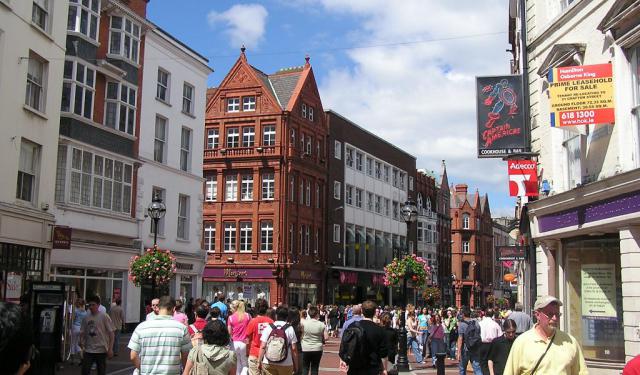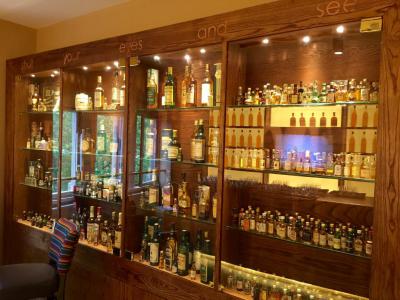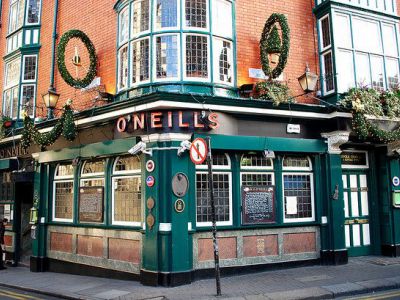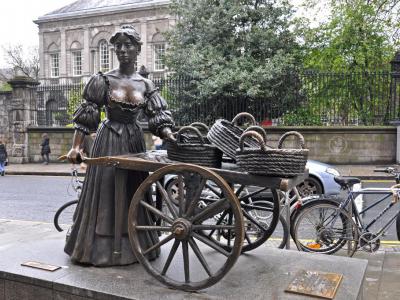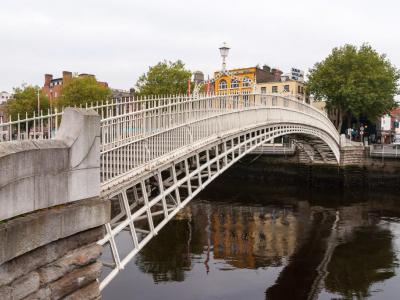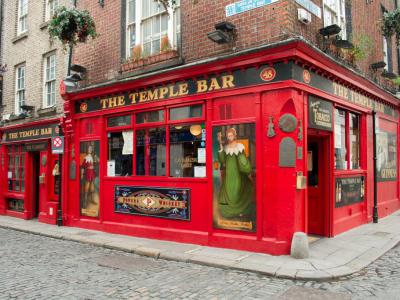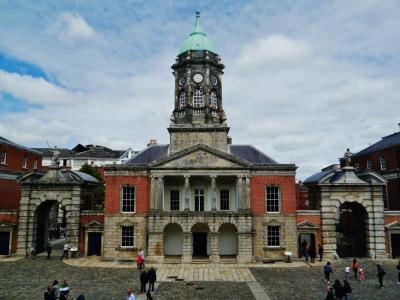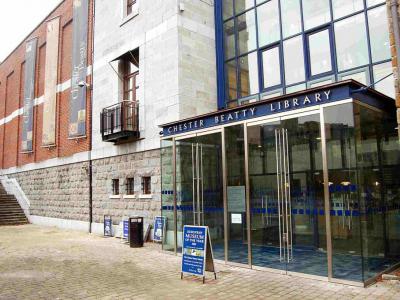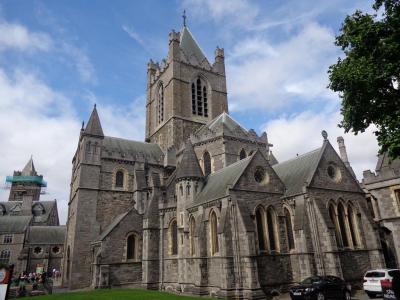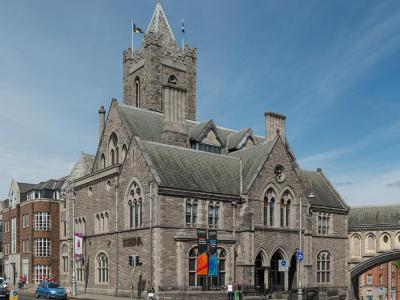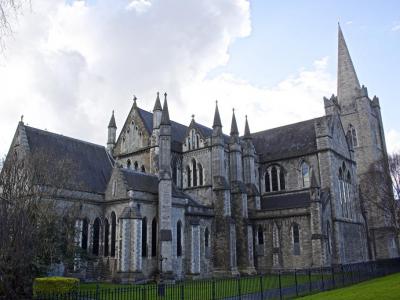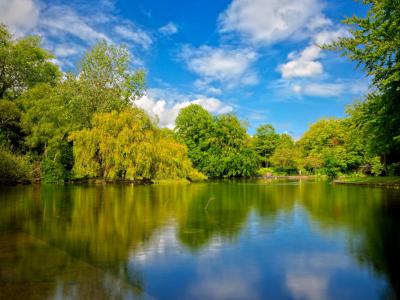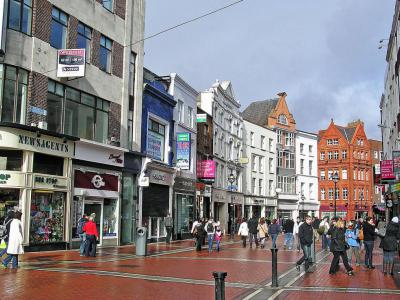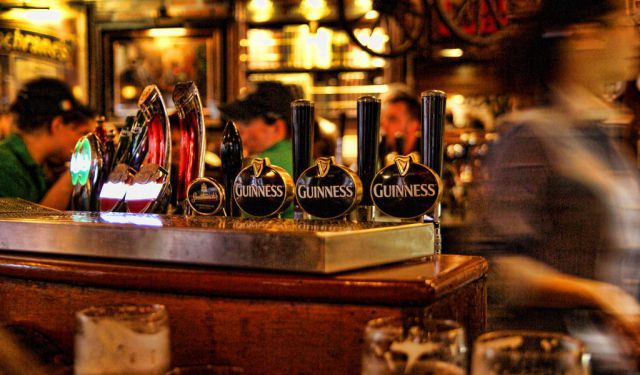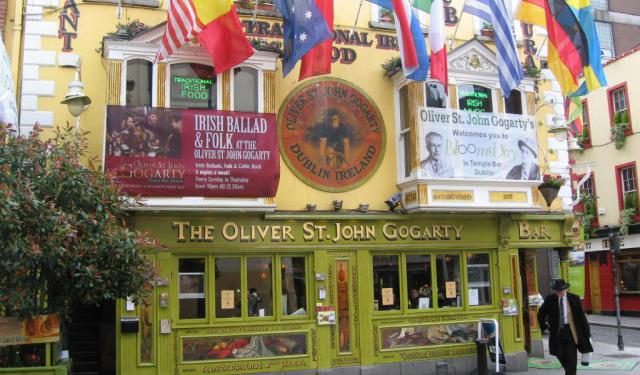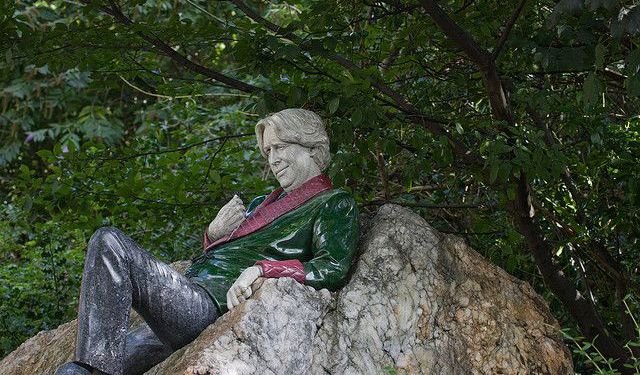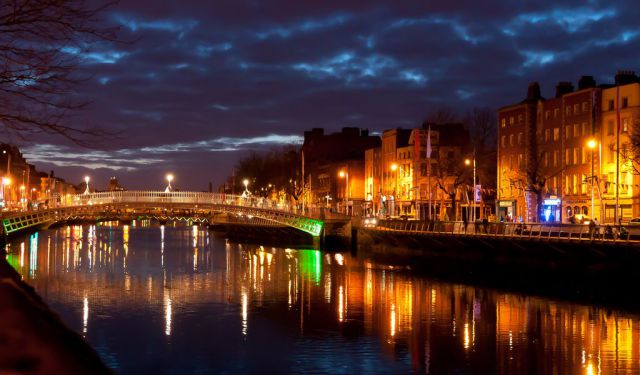Audio Guide: Dublin Introduction Walking Tour (Self Guided), Dublin
The Irish capital, Dublin, is a city where history has a pint in one hand and a smartphone in the other. Sitting snugly on Ireland’s east coast, straddling the River Liffey like it owns the place, Dublin is a heady mix of medieval charm, Georgian swagger, and modern-day buzz. The name itself, Dubh Linn (the Celtic expression for “black pool”) sounds mysterious enough - and yes, it refers to an actual tidal pool where the River Poddle once got dramatic, entering the Liffey.
Dublin's story kicks off in 988 with some Vikings dropping anchor and setting up a camp - though, truth be told, some early Christian settlers had already beaten them to it. The Norse stuck around, dodging the occasional angry native tribesmen, until the Normans crash-landed in 1169 and started a new chapter, with swords and “planning permissions.” Later, in the Tudor era, Queen Elizabeth I decided Dublin could use a little higher education - as long as it was Protestant. Thus, Trinity College was born in 1592, and it’s still showing off its fancy books today.
By the 1700s, Dublin hit the big time - second largest city of the British Empire, no less. Many of the buildings we now Instagram were built during this boom: Temple Bar, Grafton Street, all the hits. But then came the 19th century, when Dublin, following the Acts of Union, was politely told to hand its political power over to London. Subsequent decades brought decline, rebellion, and an awful lot of destruction after the Easter Rising, the War of Independence, and the Civil War that followed.
These days, Dublin is back on its feet and dancing. Trinity College still wows with the Book of Kells, while the Irish Whiskey Museum keeps the spirits high. O’Neill’s Pub & Kitchen is just around the corner if you need a feed or a fiddle tune.
Take a selfie with the Molly Malone statue, wander over the elegant Ha’penny Bridge, then dive into the cobbled chaos of Temple Bar. From the grandeur of Dublin Castle to the global treasures at the Chester Beatty Library, there's no shortage of cultural sparkle. Cathedrals? There are two - Christ Church and St. Patrick’s - both Gothic, both grand. Add Dublinia for a Viking twist, and St. Stephen’s Green for a calm exhale before tackling the shops and buskers of Grafton Street.
So lace up, charge your phone, and let Dublin charm you - one story, statue, and cheeky street musician at a time...
Dublin's story kicks off in 988 with some Vikings dropping anchor and setting up a camp - though, truth be told, some early Christian settlers had already beaten them to it. The Norse stuck around, dodging the occasional angry native tribesmen, until the Normans crash-landed in 1169 and started a new chapter, with swords and “planning permissions.” Later, in the Tudor era, Queen Elizabeth I decided Dublin could use a little higher education - as long as it was Protestant. Thus, Trinity College was born in 1592, and it’s still showing off its fancy books today.
By the 1700s, Dublin hit the big time - second largest city of the British Empire, no less. Many of the buildings we now Instagram were built during this boom: Temple Bar, Grafton Street, all the hits. But then came the 19th century, when Dublin, following the Acts of Union, was politely told to hand its political power over to London. Subsequent decades brought decline, rebellion, and an awful lot of destruction after the Easter Rising, the War of Independence, and the Civil War that followed.
These days, Dublin is back on its feet and dancing. Trinity College still wows with the Book of Kells, while the Irish Whiskey Museum keeps the spirits high. O’Neill’s Pub & Kitchen is just around the corner if you need a feed or a fiddle tune.
Take a selfie with the Molly Malone statue, wander over the elegant Ha’penny Bridge, then dive into the cobbled chaos of Temple Bar. From the grandeur of Dublin Castle to the global treasures at the Chester Beatty Library, there's no shortage of cultural sparkle. Cathedrals? There are two - Christ Church and St. Patrick’s - both Gothic, both grand. Add Dublinia for a Viking twist, and St. Stephen’s Green for a calm exhale before tackling the shops and buskers of Grafton Street.
So lace up, charge your phone, and let Dublin charm you - one story, statue, and cheeky street musician at a time...
How it works: Download the app "GPSmyCity: Walks in 1K+ Cities" from Apple App Store or Google Play Store to your mobile phone or tablet. The app turns your mobile device into a personal tour guide and its built-in GPS navigation functions guide you from one tour stop to next. The app works offline, so no data plan is needed when traveling abroad.
Dublin Introduction Walking Tour Map
Guide Name: Dublin Introduction Walking Tour
Guide Location: Ireland » Dublin (See other walking tours in Dublin)
Guide Type: Self-guided Walking Tour (Sightseeing)
# of Attractions: 13
Tour Duration: 2 Hour(s)
Travel Distance: 3.8 Km or 2.4 Miles
Author: max
Sight(s) Featured in This Guide:
Guide Location: Ireland » Dublin (See other walking tours in Dublin)
Guide Type: Self-guided Walking Tour (Sightseeing)
# of Attractions: 13
Tour Duration: 2 Hour(s)
Travel Distance: 3.8 Km or 2.4 Miles
Author: max
Sight(s) Featured in This Guide:
- Trinity College
- Irish Whiskey Museum
- O'Neill's Pub & Kitchen
- Molly Malone Statue
- Ha'penny Bridge
- Temple Bar District
- Dublin Castle
- Chester Beatty Library
- Christ Church Cathedral
- Dublinia & the Viking World (Synod Hall)
- St. Patrick's Cathedral
- St. Stephen's Green
- Grafton Street
1) Trinity College (must see)
Tucked right into Dublin’s beating heart, Trinity College is both a university and a scene-stealing diva of stone and legacy wrapped into one. Founded in 1592 by none other than Queen Elizabeth I (because what’s an empire without a bit of academic propaganda?), it was originally meant to steer Irish students away from those pesky continental Catholic ideas. Over the centuries that followed, this world-renowned institution has churned out everyone from politicians and philosophers to literary legends like Swift, Wilde, and Beckett-talk about a star-studded alumni list...
Planted on College Green like a scholarly fortress, Trinity greets you with serious old-school charm and just enough mystery. Depending on the time of year-or the mood of the security gates-you might not get full access, but the west front gate usually plays nice. Stroll through and you’ll land in Parliament Square, where symmetry reigns supreme. The Chapel and Examination Hall face off across a lawn that occasionally moonlights as a concert venue.
Keep wandering further and you’ll find the Rubrics, the college’s oldest surviving building, all red brick and 18th-century vibes. But let’s be honest-the real showstopper here is the Old Library. Not only does it smell like intellectual dust and old wisdom, it houses the legendary Book of Kells, a 9th-century masterpiece of illuminated manuscript art that’s basically medieval bling.
Also, beyond the Old Library is Fellows' Square, where old meets new. On one side: the modernist Berkeley Library and the Arts Building. On the other: the Douglas Hyde Gallery, serving up contemporary Irish and international art with a side of cool detachment.
And just when you think Trinity’s done impressing, you stumble into New Square and meet the School of Engineering. Its home is the Museum Building-an absolute fever dream of Venetian Gothic architecture, decked out with stone-carved animals, twisting leaves, and enough floral motifs to make a Victorian jealous.
In short, Trinity College campus is a storybook that you can walk through, with a little drama, a lot of history, and just the right amount of academic swagger...
Planted on College Green like a scholarly fortress, Trinity greets you with serious old-school charm and just enough mystery. Depending on the time of year-or the mood of the security gates-you might not get full access, but the west front gate usually plays nice. Stroll through and you’ll land in Parliament Square, where symmetry reigns supreme. The Chapel and Examination Hall face off across a lawn that occasionally moonlights as a concert venue.
Keep wandering further and you’ll find the Rubrics, the college’s oldest surviving building, all red brick and 18th-century vibes. But let’s be honest-the real showstopper here is the Old Library. Not only does it smell like intellectual dust and old wisdom, it houses the legendary Book of Kells, a 9th-century masterpiece of illuminated manuscript art that’s basically medieval bling.
Also, beyond the Old Library is Fellows' Square, where old meets new. On one side: the modernist Berkeley Library and the Arts Building. On the other: the Douglas Hyde Gallery, serving up contemporary Irish and international art with a side of cool detachment.
And just when you think Trinity’s done impressing, you stumble into New Square and meet the School of Engineering. Its home is the Museum Building-an absolute fever dream of Venetian Gothic architecture, decked out with stone-carved animals, twisting leaves, and enough floral motifs to make a Victorian jealous.
In short, Trinity College campus is a storybook that you can walk through, with a little drama, a lot of history, and just the right amount of academic swagger...
2) Irish Whiskey Museum (must see)
Right across from Trinity College’s grand entrance on Grafton Street-where students cram for finals and tourists snap selfies-you’ll find a place that honours Ireland’s true dual passions: history and whiskey. Welcome to the Irish Whiskey Museum, where you don’t just sip spirits, you time-travel through them...
Since swinging open its doors in 2014, the museum has been charming visitors with the tales of “water of life”, complete with live traditional music, colourful storytelling, and generous pours of single grain, pot still, malt, and blended whiskeys. Think of it as a cultural deep-dive with a high-proof twist.
The interactive tour meanders through four immersive rooms, each styled to match a different era in Irish history. By the end, you’ll be confidently nodding along to whiskey trivia like a seasoned distiller-or at least faking it very convincingly.
Craving a next-level experience? Try the Whiskey Blending Experience-90 minutes of swirling, sniffing, sipping, and finally bottling your own custom blend to take home in a neat little Irish Whiskey Museum miniature (just try not to drink it on the flight back). Or if you like your spirits with sausages, opt for the Whiskey and Brunch Experience-a weekend exclusive that pairs three whiskeys with a hearty Irish brunch. Fancy a bit more? The VIP version adds a fourth dram and a souvenir shot glass to make your liver and Instagram equally happy.
One of the museum’s standout features is that it’s not owned by any particular distillery, so the history comes neat-no brand bias, just straight-up facts and flavor.
And fear not, teetotalers and designated drivers: there are non-drinker tickets, kids are welcome on the tour, and if you’re just here for the booze (no judgment), you can skip the history and head straight to the bar. Ask for a “Whiskey Flight” to sample a curated trio, or go full cocktail mode with an Irish Coffee or whiskey sour.
Bottom line: whether you’re a whiskey rookie or a peat-loving pro, this spot will leave you buzzing-in more ways than one...
Since swinging open its doors in 2014, the museum has been charming visitors with the tales of “water of life”, complete with live traditional music, colourful storytelling, and generous pours of single grain, pot still, malt, and blended whiskeys. Think of it as a cultural deep-dive with a high-proof twist.
The interactive tour meanders through four immersive rooms, each styled to match a different era in Irish history. By the end, you’ll be confidently nodding along to whiskey trivia like a seasoned distiller-or at least faking it very convincingly.
Craving a next-level experience? Try the Whiskey Blending Experience-90 minutes of swirling, sniffing, sipping, and finally bottling your own custom blend to take home in a neat little Irish Whiskey Museum miniature (just try not to drink it on the flight back). Or if you like your spirits with sausages, opt for the Whiskey and Brunch Experience-a weekend exclusive that pairs three whiskeys with a hearty Irish brunch. Fancy a bit more? The VIP version adds a fourth dram and a souvenir shot glass to make your liver and Instagram equally happy.
One of the museum’s standout features is that it’s not owned by any particular distillery, so the history comes neat-no brand bias, just straight-up facts and flavor.
And fear not, teetotalers and designated drivers: there are non-drinker tickets, kids are welcome on the tour, and if you’re just here for the booze (no judgment), you can skip the history and head straight to the bar. Ask for a “Whiskey Flight” to sample a curated trio, or go full cocktail mode with an Irish Coffee or whiskey sour.
Bottom line: whether you’re a whiskey rookie or a peat-loving pro, this spot will leave you buzzing-in more ways than one...
3) O'Neill's Pub & Kitchen
If you ever find yourself wandering the cobbled arteries of downtown Dublin with a thirst that only a proper pint can quench, a growling belly, or a sudden craving for foot-stomping live Irish tunes, just follow the sound of laughter and fiddles to O’Neill’s. From the outside, it may look like your average pub-but step through the door and you’ll tumble into a wonderland of wooden beams, warm corners, and cozy nooks stacked like an architectural game of hide and seek. Upstairs, downstairs-it’s got layers like a good Shepherd’s Pie (which, by the way, is practically a local legend here).
This isn’t just any old watering hole-this spot has history. A tavern has been slinging drinks on this site for over 300 years. In 1875, the Hogan Brothers ran the show until M.J. O’Neill put his name over the door in 1927, and it’s stuck ever since. Nestled right in a protected conservation area, you’re mere minutes away from Temple Bar, Trinity College, and Grafton Street-but why rush off when the party’s already started?
Back in the day, O’Neill’s had its social zones neatly sorted: a fancy cocktail bar for the upper crust, a more casual public bar on Suffolk Street, and a back bar for those in the know. Fast forward to today, and those spaces have merged and morphed. They even knocked through to the building on Church Lane, turning it into a mouthwatering carvery. Oh, and don’t miss the snug-just off the Church Lane entrance-where left-wing intellectuals from Trinity once debated the fate of the world between pints.
Need a breather? O’Neill’s has you sorted there too. Step out to the beer garden or kick back in the smoking area. And if the night’s still young (or even if it’s not), the late bar will keep the good vibes rolling well into the weekend hours.
In short: come for the pint, stay for the pie, and lose track of time somewhere between a fiddle solo and a firelit booth.
This isn’t just any old watering hole-this spot has history. A tavern has been slinging drinks on this site for over 300 years. In 1875, the Hogan Brothers ran the show until M.J. O’Neill put his name over the door in 1927, and it’s stuck ever since. Nestled right in a protected conservation area, you’re mere minutes away from Temple Bar, Trinity College, and Grafton Street-but why rush off when the party’s already started?
Back in the day, O’Neill’s had its social zones neatly sorted: a fancy cocktail bar for the upper crust, a more casual public bar on Suffolk Street, and a back bar for those in the know. Fast forward to today, and those spaces have merged and morphed. They even knocked through to the building on Church Lane, turning it into a mouthwatering carvery. Oh, and don’t miss the snug-just off the Church Lane entrance-where left-wing intellectuals from Trinity once debated the fate of the world between pints.
Need a breather? O’Neill’s has you sorted there too. Step out to the beer garden or kick back in the smoking area. And if the night’s still young (or even if it’s not), the late bar will keep the good vibes rolling well into the weekend hours.
In short: come for the pint, stay for the pie, and lose track of time somewhere between a fiddle solo and a firelit booth.
4) Molly Malone Statue
Heading down Grafton Street-Dublin’s go-to catwalk for shopping, strutting, and strategic people-watching-you’ll be greeted right off the bat by none other than Molly Malone. Cast in bronze and pushing a wheelbarrow brimming with cockles and mussels, she's the city’s most debated street vendor... who may or may not have actually existed.
Immortalised in the catchy 19th-century ballad “In Dublin’s fair city…”, Molly’s story is as slippery as her seafood. Historians squint. Locals shrug. Tourists snap selfies. Was she real? A legend? A Victorian marketing ploy? Nobody really knows, but Dublin embraced her anyway-sculpted her, bronzed her, and gave her a prime spot outside Trinity College during the city's millennium bash in 1988.
Of course, things got spicy. The statue’s low-cut dress and ample assets sparked debates about decency, feminism, and artistic license. Depending on whom you ask, she’s either a celebration of old Dublin charm or a problematic pin-up. Naturally, Dubliners responded in true cheeky form-nicknaming her “The Tart with the Cart,” “The Dish with the Fish,” and, for more poetic flair, “The Trollop with the Scallop.”
As for the eponymous song, its roots are just as fuzzy. Some swear it came from Scotland, others say it was a Victorian music hall hit designed to tug heartstrings and sell tickets. Regardless, “Molly Malone” has wormed its way into the city’s DNA-crooned in pubs, belted at sports games, and now basically functioning as Ireland’s unofficial second anthem.
And if you’re truly smitten, mark your calendar: June 13th is officially Molly Malone Day. Because when Dublin falls in love with a character-even a possibly fictional, fish-slinging one-it goes all in.
Immortalised in the catchy 19th-century ballad “In Dublin’s fair city…”, Molly’s story is as slippery as her seafood. Historians squint. Locals shrug. Tourists snap selfies. Was she real? A legend? A Victorian marketing ploy? Nobody really knows, but Dublin embraced her anyway-sculpted her, bronzed her, and gave her a prime spot outside Trinity College during the city's millennium bash in 1988.
Of course, things got spicy. The statue’s low-cut dress and ample assets sparked debates about decency, feminism, and artistic license. Depending on whom you ask, she’s either a celebration of old Dublin charm or a problematic pin-up. Naturally, Dubliners responded in true cheeky form-nicknaming her “The Tart with the Cart,” “The Dish with the Fish,” and, for more poetic flair, “The Trollop with the Scallop.”
As for the eponymous song, its roots are just as fuzzy. Some swear it came from Scotland, others say it was a Victorian music hall hit designed to tug heartstrings and sell tickets. Regardless, “Molly Malone” has wormed its way into the city’s DNA-crooned in pubs, belted at sports games, and now basically functioning as Ireland’s unofficial second anthem.
And if you’re truly smitten, mark your calendar: June 13th is officially Molly Malone Day. Because when Dublin falls in love with a character-even a possibly fictional, fish-slinging one-it goes all in.
5) Ha'penny Bridge
Ask any Dubliner to name their favourite landmark, and odds are the Ha’penny Bridge will trot out at the top like a local celebrity on a victory lap. As you meander through the heart of the city, there’s a good chance you’ll end up crossing this charming cast-iron icon - Dublin’s oldest and most lovingly overphotographed pedestrian bridge, gracefully linking the north and south sides like a Victorian-era handshake.
It first opened in 1816 as the Wellington Bridge, but truth be told - nobody calls it that. The nickname "Ha’penny" stuck faster than a pub story, thanks to the halfpenny toll it once charged, which matched the fee for the seven ferries it put out of business. For a time, inflation did its thing, and the toll rose to a penny and a half, prompting locals to cheekily dub it the "Penny Ha’penny Bridge." Now, try saying that three times fast after a dram or two...
These days, crossing it is free - financially, at least. Emotionally? Well, that’s another story. Leaning against the railing under the old lanterns, taking in the ripple of the Liffey and watching Dublin unfold on either bank, you might find yourself wishing you could pay a toll just to stand here a little longer. But beware: stand still too long and you’ll find yourself getting nudged by folks who are just trying to get to work, rather than star in a romantic travel montage...
So keep it moving, take a mental snapshot, and know that for one glorious moment, you crossed a bridge that’s as much a part of Dublin’s soul as the Guinness in its veins.
It first opened in 1816 as the Wellington Bridge, but truth be told - nobody calls it that. The nickname "Ha’penny" stuck faster than a pub story, thanks to the halfpenny toll it once charged, which matched the fee for the seven ferries it put out of business. For a time, inflation did its thing, and the toll rose to a penny and a half, prompting locals to cheekily dub it the "Penny Ha’penny Bridge." Now, try saying that three times fast after a dram or two...
These days, crossing it is free - financially, at least. Emotionally? Well, that’s another story. Leaning against the railing under the old lanterns, taking in the ripple of the Liffey and watching Dublin unfold on either bank, you might find yourself wishing you could pay a toll just to stand here a little longer. But beware: stand still too long and you’ll find yourself getting nudged by folks who are just trying to get to work, rather than star in a romantic travel montage...
So keep it moving, take a mental snapshot, and know that for one glorious moment, you crossed a bridge that’s as much a part of Dublin’s soul as the Guinness in its veins.
6) Temple Bar District (must see)
Wedged between the River Liffey and Dame Street, Temple Bar is Dublin’s flamboyant comeback kid - once rundown, now a nightlife legend and cultural hotspot, buzzing with tourists, buskers, and the occasional lost Viking spirit. Its cobbled lanes - yes, those charming, ankle-twisting 18th-century originals - are narrow, partly pedestrianized, and soaked in both Guinness and history.
You can wander in from Dame Street, or better yet, glide through the Merchants Arch - a photogenic stone portal opposite the Ha’penny Bridge - and step into the thumping heart of Temple Bar Square. Around here, between the arch and the fortress-like Central Bank, you’ll find a vibrant mess of art centres, souvenir-heavy shops, pubs on a mission, and eateries slinging everything from Irish stew to vegan tacos.
Keep walking and you’ll hit Eustace Street and Meeting House Square, where Dublin’s brainier side comes out to play. The Irish Film Institute screens arthouse flicks, foreign gems, and the occasional cinematic head-scratcher - all served up with excellent coffee, a bar, and a gift shop full of film theory and stylish posters. A few cobbles away, Photo Museum Ireland captures Dublin in frames past and present, while the National Photographic Archive next door lets you deep-dive into Ireland’s collective memory - or just browse a moody exhibition and pretend you're curating it.
Art fans, head to the Project Arts Centre on East Essex Street. It’s got edgy exhibitions, a theatre upstairs, and just enough blue lighting to make you feel like you’re in a European indie film. Around the corner, the Button Factory pumps out live music and late-night basslines, while Jam Art Factory lets you bring home some top-tier Irish creativity - minus the hangover...
And just when you think Temple Bar has given you all its goods, look south to Dame Street. There stands the Olympia Theatre, a Victorian dazzler complete with stained-glass canopy and more red velvet than your granny’s sitting room. Across the way, City Hall shows off with its Corinthian columns, and just a stone’s throw west, Dublin Castle reminds you that even in this city of pints and performance, the past still holds court.
Welcome to Temple Bar: come for the chaos, stay for the culture!
You can wander in from Dame Street, or better yet, glide through the Merchants Arch - a photogenic stone portal opposite the Ha’penny Bridge - and step into the thumping heart of Temple Bar Square. Around here, between the arch and the fortress-like Central Bank, you’ll find a vibrant mess of art centres, souvenir-heavy shops, pubs on a mission, and eateries slinging everything from Irish stew to vegan tacos.
Keep walking and you’ll hit Eustace Street and Meeting House Square, where Dublin’s brainier side comes out to play. The Irish Film Institute screens arthouse flicks, foreign gems, and the occasional cinematic head-scratcher - all served up with excellent coffee, a bar, and a gift shop full of film theory and stylish posters. A few cobbles away, Photo Museum Ireland captures Dublin in frames past and present, while the National Photographic Archive next door lets you deep-dive into Ireland’s collective memory - or just browse a moody exhibition and pretend you're curating it.
Art fans, head to the Project Arts Centre on East Essex Street. It’s got edgy exhibitions, a theatre upstairs, and just enough blue lighting to make you feel like you’re in a European indie film. Around the corner, the Button Factory pumps out live music and late-night basslines, while Jam Art Factory lets you bring home some top-tier Irish creativity - minus the hangover...
And just when you think Temple Bar has given you all its goods, look south to Dame Street. There stands the Olympia Theatre, a Victorian dazzler complete with stained-glass canopy and more red velvet than your granny’s sitting room. Across the way, City Hall shows off with its Corinthian columns, and just a stone’s throw west, Dublin Castle reminds you that even in this city of pints and performance, the past still holds court.
Welcome to Temple Bar: come for the chaos, stay for the culture!
7) Dublin Castle (must see)
Standing tall and slightly smug on a ridge above the River Liffey, Dublin Castle is like that one friend who’s seen it all and still dresses sharp. This place packs over 800 years of drama - Vikings, royals, revolts, and a whole lot of renovations - into one surprisingly elegant complex.
Originally whipped up by the Anglo-Normans in the 1200s, it was built over a Viking settlement and served as the control center of English (and later British) rule in Ireland for seven centuries. A fire in 1684 charred most of the medieval bits, so the castle reinvented itself in the 18th century with Georgian flair. Think less fortress, more fancy manor - though if you join a guided tour, you can still find some medieval bones beneath the beauty.
The Upper Yard keeps the old castle layout alive, while the Cork Hill entrance, topped with a statue of Justice, offers a not-so-subtle historical joke - Lady Justice turns her back to the city. Not shady at all...
Inside, you’ll find the plush State Apartments, where British viceroys once threw parties and where Irish presidents now make things official. Expect glittering chandeliers, dramatic tapestries, and a strong "please don't touch" vibe. The nearby Chapel Royal, all Gothic charm and carved woodwork, is open for a peek - though the only thing being preached nowadays is great design.
Go underground and time-travel even further back: you’ll spot the remains of a Viking wall and the famed Dubh Linn (or “Black Pool”) that gave Dublin its name. Above ground, in that very spot, the Dubhlinn Gardens now bloom in Celtic patterns - ideal for pretending you’re in a historical drama, minus the beheadings...
And don’t skip the Chester Beatty Library set behind the castle walls. This under-the-radar gem is packed with ancient manuscripts and rare books from all over the world - basically, the Louvre of library nerds.
Dublin Castle isn’t just a relic of power; it’s a mash-up of past and present, stateliness and surprises. No matter if you're here for the politics, the Vikings, or the velvet furniture, it’s the kind of place that makes history feel less like homework and more like a plot twist.
Originally whipped up by the Anglo-Normans in the 1200s, it was built over a Viking settlement and served as the control center of English (and later British) rule in Ireland for seven centuries. A fire in 1684 charred most of the medieval bits, so the castle reinvented itself in the 18th century with Georgian flair. Think less fortress, more fancy manor - though if you join a guided tour, you can still find some medieval bones beneath the beauty.
The Upper Yard keeps the old castle layout alive, while the Cork Hill entrance, topped with a statue of Justice, offers a not-so-subtle historical joke - Lady Justice turns her back to the city. Not shady at all...
Inside, you’ll find the plush State Apartments, where British viceroys once threw parties and where Irish presidents now make things official. Expect glittering chandeliers, dramatic tapestries, and a strong "please don't touch" vibe. The nearby Chapel Royal, all Gothic charm and carved woodwork, is open for a peek - though the only thing being preached nowadays is great design.
Go underground and time-travel even further back: you’ll spot the remains of a Viking wall and the famed Dubh Linn (or “Black Pool”) that gave Dublin its name. Above ground, in that very spot, the Dubhlinn Gardens now bloom in Celtic patterns - ideal for pretending you’re in a historical drama, minus the beheadings...
And don’t skip the Chester Beatty Library set behind the castle walls. This under-the-radar gem is packed with ancient manuscripts and rare books from all over the world - basically, the Louvre of library nerds.
Dublin Castle isn’t just a relic of power; it’s a mash-up of past and present, stateliness and surprises. No matter if you're here for the politics, the Vikings, or the velvet furniture, it’s the kind of place that makes history feel less like homework and more like a plot twist.
8) Chester Beatty Library (must see)
Tucked behind Dublin Castle like a literary treasure chest hiding in plain sight, the Chester Beatty Library is more than just a "nice little museum" - it’s a full-on cultural blockbuster in compact form. Housed in the old Clock Tower and curated by none other than American mining magnate and book-collecting legend Alfred Chester Beatty, this place is the best small museum in Ireland, but also one of Europe’s finest, full stop.
Step inside and you’re greeted by “Arts of the Book” on the ground floor - a glittering showcase of manuscripts and artwork from across Western, Islamic, and East Asian traditions. We’re talking jade books from China so fine you’d think they were crafted by mythical beings, and illuminated manuscripts so detailed they could outshine the Book of Kells at a medieval disco. Need more? There are audiovisuals that walk you through the old-school magic of bookbinding, paper-making, and printing - like Masterclass, but make it ancient and exquisite.
Climb the stairs to the second floor, and it’s time for “Sacred Traditions.” This section takes you on a world tour of religious art and writing - no passport needed. It features over 270 Qur’ans from the 9th to 19th centuries, arguably the finest illuminated collection on Earth. Add to that ancient Egyptian love poems from the 12th century BC (yes, ancient people had feelings too), gospels from as early as 200 AD, and scrolls from China, Japan, and Tibet so intricate they might just reboot your spiritual settings.
So, if you're into rare books, world religions, or just want to impress your friends with something that isn’t Guinness-related - this one is for you.
Pro tip:
When your eyes need a break from all that visual poetry, pop over to the Silk Road Café in the back - it’s a quiet culinary journey that pairs perfectly with the global exhibits. Or take a breather in the rooftop meditation garden, where the only sound is your own awe. Bonus points if you check out the front gardens for sweeping views of the Castle and a quick reality check that yes, you're still in Dublin...
Step inside and you’re greeted by “Arts of the Book” on the ground floor - a glittering showcase of manuscripts and artwork from across Western, Islamic, and East Asian traditions. We’re talking jade books from China so fine you’d think they were crafted by mythical beings, and illuminated manuscripts so detailed they could outshine the Book of Kells at a medieval disco. Need more? There are audiovisuals that walk you through the old-school magic of bookbinding, paper-making, and printing - like Masterclass, but make it ancient and exquisite.
Climb the stairs to the second floor, and it’s time for “Sacred Traditions.” This section takes you on a world tour of religious art and writing - no passport needed. It features over 270 Qur’ans from the 9th to 19th centuries, arguably the finest illuminated collection on Earth. Add to that ancient Egyptian love poems from the 12th century BC (yes, ancient people had feelings too), gospels from as early as 200 AD, and scrolls from China, Japan, and Tibet so intricate they might just reboot your spiritual settings.
So, if you're into rare books, world religions, or just want to impress your friends with something that isn’t Guinness-related - this one is for you.
Pro tip:
When your eyes need a break from all that visual poetry, pop over to the Silk Road Café in the back - it’s a quiet culinary journey that pairs perfectly with the global exhibits. Or take a breather in the rooftop meditation garden, where the only sound is your own awe. Bonus points if you check out the front gardens for sweeping views of the Castle and a quick reality check that yes, you're still in Dublin...
9) Christ Church Cathedral (must see)
Step into the Christ Church Cathedral - here, medieval majesty meets a touch of mystery, and not everything is quite what it seems. While the cathedral's story begins back in the 12th and 13th centuries, time wasn’t always kind to the original structure. By the 1870s, it was crumbling faster than a biscuit in tea. Luckily, Henry Roe, a 19th-century whiskey magnate and unlikely architectural hero, bankrolled its full-scale reconstruction. The result was a faithful revival of Romanesque and Early English Gothic splendour, with a pinch of Victorian flourish.
Wander the grounds and you’ll stumble across ghostly echoes of the past: a ruined 13th-century chapter house in the courtyard, and inside the southern aisle, a knight’s tomb - the monument's nose suspiciously missing. Local legend suggests that it’s Strongbow’s (the nobleman in charge of the Anglo-Norman invasion of Ireland) final resting place, though historians claim otherwise that his original tomb was lost in a 1562 collapse of the south wall. Still, it makes for a dramatic photo op.
Don't miss the Peace Chapel, where the heart of Archbishop Laurence O’Toole - Dublin’s patron saint and 12th-century peacemaker - sits encased in a reliquary, beating metaphorically with centuries of reverence.
And now for something truly bizarre: behold “Tom and Jerry,” a mummified cat-and-rat duo frozen mid-chase inside a church organ. Yep, you heard that right. Add in some oddly tilted arches on the north aisle, and you’ve got yourself a guided tour through ecclesiastical eccentricity.
Venture down into the cathedral’s crypt - the oldest surviving structure in Dublin - and prepare to be both amazed and mildly unsettled. Among ancient tombs and treasures, you’ll find regal statues of Charles I and II looking a bit smug, and sparkling silverware gifted by William of Orange after he thrashed his rival in 1690 at the Battle of the Boyne.
Open daily, the cathedral also hosts spellbinding Evensong services, with music that dates back to the Reformation - ideal if you like your choir with a side of history. And if you're feeling brave (or simply bell-curious), guided tours up to the belfry let you ring a bell and enjoy panoramic views over the city.
Let’s just say: it’s not your average Sunday visit.
Wander the grounds and you’ll stumble across ghostly echoes of the past: a ruined 13th-century chapter house in the courtyard, and inside the southern aisle, a knight’s tomb - the monument's nose suspiciously missing. Local legend suggests that it’s Strongbow’s (the nobleman in charge of the Anglo-Norman invasion of Ireland) final resting place, though historians claim otherwise that his original tomb was lost in a 1562 collapse of the south wall. Still, it makes for a dramatic photo op.
Don't miss the Peace Chapel, where the heart of Archbishop Laurence O’Toole - Dublin’s patron saint and 12th-century peacemaker - sits encased in a reliquary, beating metaphorically with centuries of reverence.
And now for something truly bizarre: behold “Tom and Jerry,” a mummified cat-and-rat duo frozen mid-chase inside a church organ. Yep, you heard that right. Add in some oddly tilted arches on the north aisle, and you’ve got yourself a guided tour through ecclesiastical eccentricity.
Venture down into the cathedral’s crypt - the oldest surviving structure in Dublin - and prepare to be both amazed and mildly unsettled. Among ancient tombs and treasures, you’ll find regal statues of Charles I and II looking a bit smug, and sparkling silverware gifted by William of Orange after he thrashed his rival in 1690 at the Battle of the Boyne.
Open daily, the cathedral also hosts spellbinding Evensong services, with music that dates back to the Reformation - ideal if you like your choir with a side of history. And if you're feeling brave (or simply bell-curious), guided tours up to the belfry let you ring a bell and enjoy panoramic views over the city.
Let’s just say: it’s not your average Sunday visit.
10) Dublinia & the Viking World (Synod Hall)
Set inside the storybook-worthy Synod Hall-just across from Christ Church Cathedral and charmingly connected by a stone bridge-Dublinia & the Viking World isn’t your average history museum. This place flings you headfirst into the gritty, grimy, gloriously chaotic streets of Viking and medieval Dublin. Ideal for families, especially during summer when special events pop up (yes, check the website-time travel does require a bit of planning).
Here, history doesn't whisper politely-it bellows! Walk-through exhibits take you from plague-ridden alleys to rowdy medieval markets, complete with sound effects, moody lighting, and the occasional suspicious smell. Don’t worry, it’s all part of the immersive charm.
Want to dig deeper? Literally? Head into the archaeology room, where you can poke around a recreated excavation site and play scientist in a lab, squinting at ancient artifacts through microscopes like a true relic detective.
Climb upstairs to the old Anglican bishops’ meeting hall-now dramatically repurposed as Viking World. The star of the show is a nearly full-sized Viking longship that looks ready to set sail down the Liffey. Watch dramatic saga-filled videos, try out Viking games, and yes, if you're curious about fashion from a less liberated era, you can try on a set of replica slave chains. Charming...
And for those who like their history with a view, don’t skip the climb up St. Michael’s Tower. The steps are real, the breeze is fresh, and the panoramic sweep of Dublin’s rooftops is worth every stair.
Indeed, Dublinia is where history growls, grins, and occasionally smells like fish stew...
Here, history doesn't whisper politely-it bellows! Walk-through exhibits take you from plague-ridden alleys to rowdy medieval markets, complete with sound effects, moody lighting, and the occasional suspicious smell. Don’t worry, it’s all part of the immersive charm.
Want to dig deeper? Literally? Head into the archaeology room, where you can poke around a recreated excavation site and play scientist in a lab, squinting at ancient artifacts through microscopes like a true relic detective.
Climb upstairs to the old Anglican bishops’ meeting hall-now dramatically repurposed as Viking World. The star of the show is a nearly full-sized Viking longship that looks ready to set sail down the Liffey. Watch dramatic saga-filled videos, try out Viking games, and yes, if you're curious about fashion from a less liberated era, you can try on a set of replica slave chains. Charming...
And for those who like their history with a view, don’t skip the climb up St. Michael’s Tower. The steps are real, the breeze is fresh, and the panoramic sweep of Dublin’s rooftops is worth every stair.
Indeed, Dublinia is where history growls, grins, and occasionally smells like fish stew...
11) St. Patrick's Cathedral (must see)
Saint Patrick’s Cathedral – Dublin’s oldest and tallest church, and possibly the only place where getting baptized by a saint, attending university, and stabling your horse all happened under the same roof...
Legend has it that Saint Patrick himself once dunked a few converts right here – a Celtic cross in the nave marks the alleged holy splash zone, dating things back to around 450 AD. Outside, there’s a peaceful park and a marker showing where the Holy Well once was – a perfect spot for pondering ancient blessings or just enjoying your sandwich...
Inside, the cathedral stretches an impressive 90 meters long, making it the longest church in Ireland – and tall too, with a 45-meter tower that houses the country’s largest peal of bells. Keep your ears ready and your neck limber. Above the choir stalls, look up to see carved helmets and swords – because sometimes "divine inspiration" can arrive amid medieval battle accessories.
Most of what you see today isn’t from the original 1191 structure, though. A fire in the 14th century did a number on it, and later restorations – especially in the Victorian era – gave it the grandeur we see now, minus the medieval draft...
This place has worn many hats over the centuries. In 1320, it was home to Ireland’s first university. Later, under Cromwell, it became an impromptu barracks – complete with equestrian parking in the aisles. But one of its most famous residents was Jonathan Swift, author of Gulliver’s Travels, who served as dean from 1713 to 1745. Known for his razor-sharp wit and concern for Dublin’s poor, Swift is buried here alongside Esther Johnson (otherwise known as "Stella," an Englishwoman and a close friend of Swift's). His pulpit and self-penned epitaph are still on display here, just in case you’d like to hear from the man himself, posthumously...
And then there's the door. Not just any door – but the door. A medieval peace treaty carved in wood. During a 1492 siege, Lord Kildare literally "chanced his arm" by cutting a hole in a door and reaching through to shake hands with his enemy. A bold move, and the source of a phrase still alive and kicking today.
Quick tip:
Check the cathedral’s website for upcoming concerts or events – because if you’re going to soak in history, you might as well do it with a choir echoing around you.
Legend has it that Saint Patrick himself once dunked a few converts right here – a Celtic cross in the nave marks the alleged holy splash zone, dating things back to around 450 AD. Outside, there’s a peaceful park and a marker showing where the Holy Well once was – a perfect spot for pondering ancient blessings or just enjoying your sandwich...
Inside, the cathedral stretches an impressive 90 meters long, making it the longest church in Ireland – and tall too, with a 45-meter tower that houses the country’s largest peal of bells. Keep your ears ready and your neck limber. Above the choir stalls, look up to see carved helmets and swords – because sometimes "divine inspiration" can arrive amid medieval battle accessories.
Most of what you see today isn’t from the original 1191 structure, though. A fire in the 14th century did a number on it, and later restorations – especially in the Victorian era – gave it the grandeur we see now, minus the medieval draft...
This place has worn many hats over the centuries. In 1320, it was home to Ireland’s first university. Later, under Cromwell, it became an impromptu barracks – complete with equestrian parking in the aisles. But one of its most famous residents was Jonathan Swift, author of Gulliver’s Travels, who served as dean from 1713 to 1745. Known for his razor-sharp wit and concern for Dublin’s poor, Swift is buried here alongside Esther Johnson (otherwise known as "Stella," an Englishwoman and a close friend of Swift's). His pulpit and self-penned epitaph are still on display here, just in case you’d like to hear from the man himself, posthumously...
And then there's the door. Not just any door – but the door. A medieval peace treaty carved in wood. During a 1492 siege, Lord Kildare literally "chanced his arm" by cutting a hole in a door and reaching through to shake hands with his enemy. A bold move, and the source of a phrase still alive and kicking today.
Quick tip:
Check the cathedral’s website for upcoming concerts or events – because if you’re going to soak in history, you might as well do it with a choir echoing around you.
12) St. Stephen's Green (must see)
Not in the mood to play the "wait-for-a-table" game downtown? No problem. Just grab yourself a sandwich, a drink, and a little bit of rebellious charm, then head south to St. Stephen’s Green - Dublin’s answer to stress, queues, and too many menus.
Sprawling across 22 leafy acres at the foot of Grafton Street, this Georgian-era park is where grazing sheep once roamed - before it got a serious glow-up in the 18th century and became the place to see and be seen. By the late 1800s, it was given a full Victorian makeover, complete with manicured lawns, flowerbeds that would shame your grandma’s garden, shady tree-lined walks, fountains doing their best impression of zen, and benches galore, all circling an elegant lake where ducks reign supreme. Summer bonus: live music sometimes pops up in the open air. Feel free to bring snacks; they won’t judge...
This green rectangle of calm is ringed by fancy Georgian houses and dotted with more statues and memorials than you can count on two hands - or even four if you’re multitasking. Sir Arthur Guinness (yes, that same Guinness fellow) has pride of place for gifting the land to the public. Theobald Wolfe Tone, Irish revolutionary, is encircled by towering stones locals affectionately call “Tonehenge.” There’s also the Three Fates - a thank-you from post-WWII Germany for Ireland’s help with war orphans - and striking sculptures of Robert Emmet and James Joyce, the latter possibly judging your inner monologue.
And if you’re into poignant history, the park has that too. The Yeats Memorial Garden features work by Henry Moore; the Fusiliers Arch recalls fallen soldiers of the Boer War; a nod to Jeremiah O'Donovan Rossa of the Irish Republican Brotherhood; and a famine memorial quietly reminds us of the devastating years between 1845 and 1850.
Pro tip:
Before or after your stroll, check out the charming cafés just outside the gates. Cake, coffee, and green views - it’s the holy trinity of a perfect Dublin afternoon.
Sprawling across 22 leafy acres at the foot of Grafton Street, this Georgian-era park is where grazing sheep once roamed - before it got a serious glow-up in the 18th century and became the place to see and be seen. By the late 1800s, it was given a full Victorian makeover, complete with manicured lawns, flowerbeds that would shame your grandma’s garden, shady tree-lined walks, fountains doing their best impression of zen, and benches galore, all circling an elegant lake where ducks reign supreme. Summer bonus: live music sometimes pops up in the open air. Feel free to bring snacks; they won’t judge...
This green rectangle of calm is ringed by fancy Georgian houses and dotted with more statues and memorials than you can count on two hands - or even four if you’re multitasking. Sir Arthur Guinness (yes, that same Guinness fellow) has pride of place for gifting the land to the public. Theobald Wolfe Tone, Irish revolutionary, is encircled by towering stones locals affectionately call “Tonehenge.” There’s also the Three Fates - a thank-you from post-WWII Germany for Ireland’s help with war orphans - and striking sculptures of Robert Emmet and James Joyce, the latter possibly judging your inner monologue.
And if you’re into poignant history, the park has that too. The Yeats Memorial Garden features work by Henry Moore; the Fusiliers Arch recalls fallen soldiers of the Boer War; a nod to Jeremiah O'Donovan Rossa of the Irish Republican Brotherhood; and a famine memorial quietly reminds us of the devastating years between 1845 and 1850.
Pro tip:
Before or after your stroll, check out the charming cafés just outside the gates. Cake, coffee, and green views - it’s the holy trinity of a perfect Dublin afternoon.
13) Grafton Street (must see)
Finding yourself in Grafton Street, you may feel like the spirit of Dublin is pulling on your sleeve, jingling in your pocket, and occasionally singing you a love song... This iconic pedestrian paradise stretches from the scholarly shadows of Trinity College to the leafy calm of St. Stephen’s Green, and indeed, this isn’t just a path, it’s a performance.
Named after the first Duke of Grafton (who likely never imagined his name would end up on shopping bags and street musician setlists), the street started off as a sleepy lane in the early 1700s. Fast forward a century or three, and it’s become Dublin’s unofficial catwalk for window shoppers, chocolate lovers, and busking hopefuls.
When cars were banned in 1982, Grafton Street didn’t merely sigh in relief - it bloomed. With its redbrick paving and carefree foot traffic, it turned into the city’s beating retail heart. Here, luxury and tradition shake hands daily: Brown Thomas, Dublin’s answer to London's Harrods, anchors the street, with stalwarts like Marks & Spencer, Weir & Sons, and the ever-sparkling Arnotts not far behind.
For a breather, duck into Bewley’s Oriental Café, where stained glass windows and velvet booths are the warm-up act to a killer cappuccino. Or satisfy your sweet side at Butlers Chocolate Café, where the drinks come with bonus truffles and a small dose of serotonin.
But shopping is just the start. Grafton Street is basically a stage where no one auditions - they just show up. Buskers, living statues, folk duos, jazz guitarists, and the occasional flaming juggler transform this strip into the friendliest street theatre around. In fact, singer-songwriters like Glen Hansard and Damien Rice cut their teeth right here, strumming before they were streaming.
And if the crowds get too thick, just take a sidestep. South Anne Street leads you into a more intimate rhythm, and the Powerscourt Townhouse Centre - once an 18th-century mansion, now a boutique arcade - offers elegance, quiet, and espresso-fueled calm.
So, whether you’re here to spend, snack, strum, or stare - Grafton Street is Dublin at its most charmingly alive. Just be warned: you may come for the shops, but you’ll leave humming a tune you didn’t know you knew...
Named after the first Duke of Grafton (who likely never imagined his name would end up on shopping bags and street musician setlists), the street started off as a sleepy lane in the early 1700s. Fast forward a century or three, and it’s become Dublin’s unofficial catwalk for window shoppers, chocolate lovers, and busking hopefuls.
When cars were banned in 1982, Grafton Street didn’t merely sigh in relief - it bloomed. With its redbrick paving and carefree foot traffic, it turned into the city’s beating retail heart. Here, luxury and tradition shake hands daily: Brown Thomas, Dublin’s answer to London's Harrods, anchors the street, with stalwarts like Marks & Spencer, Weir & Sons, and the ever-sparkling Arnotts not far behind.
For a breather, duck into Bewley’s Oriental Café, where stained glass windows and velvet booths are the warm-up act to a killer cappuccino. Or satisfy your sweet side at Butlers Chocolate Café, where the drinks come with bonus truffles and a small dose of serotonin.
But shopping is just the start. Grafton Street is basically a stage where no one auditions - they just show up. Buskers, living statues, folk duos, jazz guitarists, and the occasional flaming juggler transform this strip into the friendliest street theatre around. In fact, singer-songwriters like Glen Hansard and Damien Rice cut their teeth right here, strumming before they were streaming.
And if the crowds get too thick, just take a sidestep. South Anne Street leads you into a more intimate rhythm, and the Powerscourt Townhouse Centre - once an 18th-century mansion, now a boutique arcade - offers elegance, quiet, and espresso-fueled calm.
So, whether you’re here to spend, snack, strum, or stare - Grafton Street is Dublin at its most charmingly alive. Just be warned: you may come for the shops, but you’ll leave humming a tune you didn’t know you knew...
Walking Tours in Dublin, Ireland
Create Your Own Walk in Dublin
Creating your own self-guided walk in Dublin is easy and fun. Choose the city attractions that you want to see and a walk route map will be created just for you. You can even set your hotel as the start point of the walk.
Pub Crawl
The Irish in general and Dubliners in particular are known for their passion for whiskey and beer. As you embark upon a beguiling odyssey through the spirited streets of the Irish capital, you can't help noticing the reverberating vibrancy coming from its enchanting pubs. A tapestry of libation-laden lore awaits those who traverse the path of the Dublin pub crawl, guided by the siren call of... view more
Tour Duration: 2 Hour(s)
Travel Distance: 2.4 Km or 1.5 Miles
Tour Duration: 2 Hour(s)
Travel Distance: 2.4 Km or 1.5 Miles
Dublin Literary Pubs
The three Ps of Dublin – the pub, the poet, and the pint – have always distinguished the Irish capital as home to some of the most literary pubs in Europe. Indeed, Dublin's public houses, where writers traditionally sharpened their wit, today encapsulate the enchantment of the written word and play a significant role in preserving and celebrating this legacy.
Among these revered... view more
Tour Duration: 1 Hour(s)
Travel Distance: 2.2 Km or 1.4 Miles
Among these revered... view more
Tour Duration: 1 Hour(s)
Travel Distance: 2.2 Km or 1.4 Miles
A Walk with Famous Irish Writers
Albeit a small country, Ireland has given the world a plethora of remarkable writers and poets, many of whom were born, lived, and studied in Dublin. Needless to say, as an epicenter of Ireland's literary scene, Dublin boasts a myriad of hallowed locations closely associated with the luminaries of Irish literature, such as James Joyce, William Butler Yeats, Samuel Beckett, and many of their... view more
Tour Duration: 2 Hour(s)
Travel Distance: 4.5 Km or 2.8 Miles
Tour Duration: 2 Hour(s)
Travel Distance: 4.5 Km or 2.8 Miles
A Walk Along Liffey River
The River Liffey - Dublin’s liquid backbone - slices through the Irish capital like a great shimmering bookmark, separating the Northside from the Southside in a civil yet longstanding sibling rivalry. Stretching around 125 kilometers, this body of water is indeed a living archive, a story that never quite ends. Stroll along its banks, and you’ll find yourself time-traveling without the hassle... view more
Tour Duration: 1 Hour(s)
Travel Distance: 2.1 Km or 1.3 Miles
Tour Duration: 1 Hour(s)
Travel Distance: 2.1 Km or 1.3 Miles
Useful Travel Guides for Planning Your Trip
16 Distinctively Irish Things to Buy in Dublin
The birthplace of many artistic talents, such as Jonathan Swift and Oscar Wilde, Dublin is the show-window of Ireland, a small country renowned for its rich cultural scene encompassing music, writing, poetry, dance, craftsmanship and more. The food & drink scene of Dublin (much as the whole of...
The Most Popular Cities
/ view all
